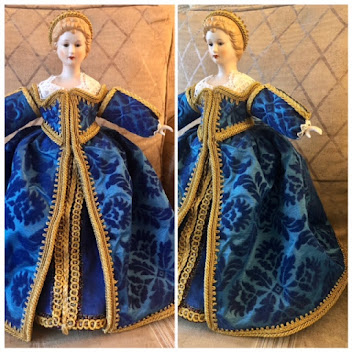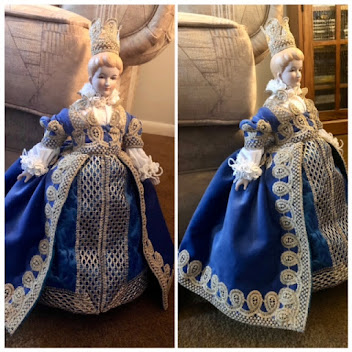In recapping the research, I have a few written accounts from influential people of the time. One extant doll housed in a museum in Stockholm, one clockwork doll housed in a museum in Vienna, a 1530 German doll/figurine made of wood and painted in a German museum, and 20 or so portraits of affluent little girls under 3 with fashion dolls of adults women from 6 different European countries. So it’s all over the place geographically as far as the the sources are concerned.
Looking at the references from this recent book. Since there are some pre-16th century references. I have instances of dolls mentioned in An Illustrated Guide to the Dolls as Used in Fashion By Max Von Boehn.
The fashion doll first makes its appearance in the account books of the French Court. Queen Isabeau of Bavaria got dolls sent to the Queen of England to give that youthful monarch an idea of the fashions of the French Court. In 1396 Robert de Varennes, the Court tailor of Charles VI, received 459 francs for a doll’s wardrobe executed by him. As this was a considerable sum, it is to be concluded that the dolls were life-size, made to the measure of the English Queen. The next record dates from a century later. In 1496 Anne of Brittany, the then reigning queen, ordered a great doll to be made and dressed for the Spanish Queen, Isabella the Catholic. Isabella was then forty-three years old, an age which in a period when girls were wont to marry at fourteen years seemedto be on the threshold of senility, but was very smart and particular about her dress, never giving audience to foreign ambassadors twice in the same costume. This fact must have been well enough known in the French Court; the actual dress put on this doll was deemed to be wanting in perfection, and it was decided to re-equip it with a much costlier ensemble. Marie de’ Medici, when Henry IV, no longer in his first youth, took her as his second wife, was full of eagerness to learn all about the prevailing French fashions. “Frontenac tells me,” writes the King to her,” that you wish to have samples of our fashions: I am therefore sending you several model dolls.
Some things to consider as I continue to work on the topic for the medieval dolls series.
Dolls on the horizon,
THL Marrin O’Cadhla





No comments:
Post a Comment